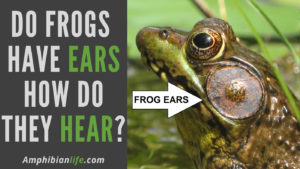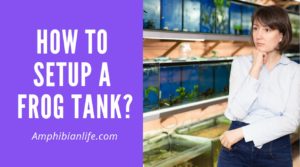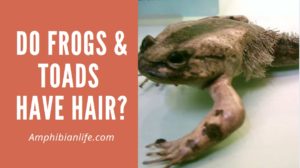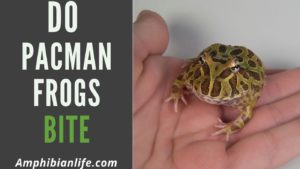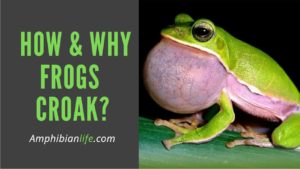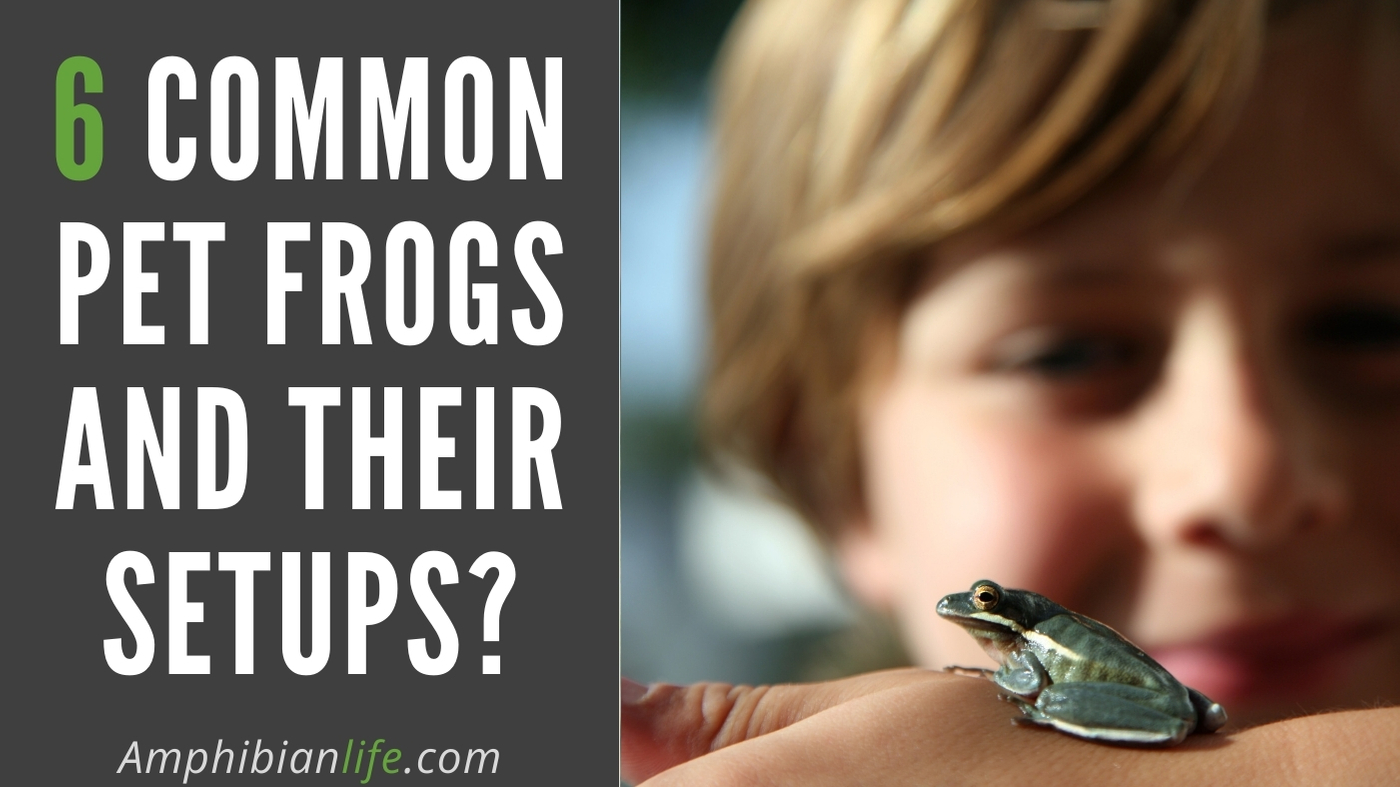
Putting a definition on the “Most common pet frogs” is difficult because it is somewhat based on opinion.
Some frogs are more common to hold as pets than others simply because they are easier to care for.
The article below is my take on which frogs are the most common pets and why.
Most Common Pet Frogs:
- Pacman Frog (Ceratophrys ornata and Ceratophrys cranwelli)
- Red-eyed tree frog (Agalychnis callidryas)
- Pixie frog (Pyxicephalus adspersus)
- Tomato frog (Dyscophus guineti)
- White’s tree frog (Litoria Caerulea)
- Green tree frog (Hyla cinerea)
Whether you want a Pacman frog, a red-eyed tree frog, or something that isn’t even on the list, you should know what you get yourself into before you buy one.
It is important to find out as much as possible about each frog before you can decide which pet frog is the best for you. So let’s get to it!
Pacman Frog
Name: Pacman frog (Ceratophrys ornata and Ceratophrys cranwelli)
Length: 2-7 inches (females are bigger than males)
Life span: Pacman frogs live for about 6-15 years
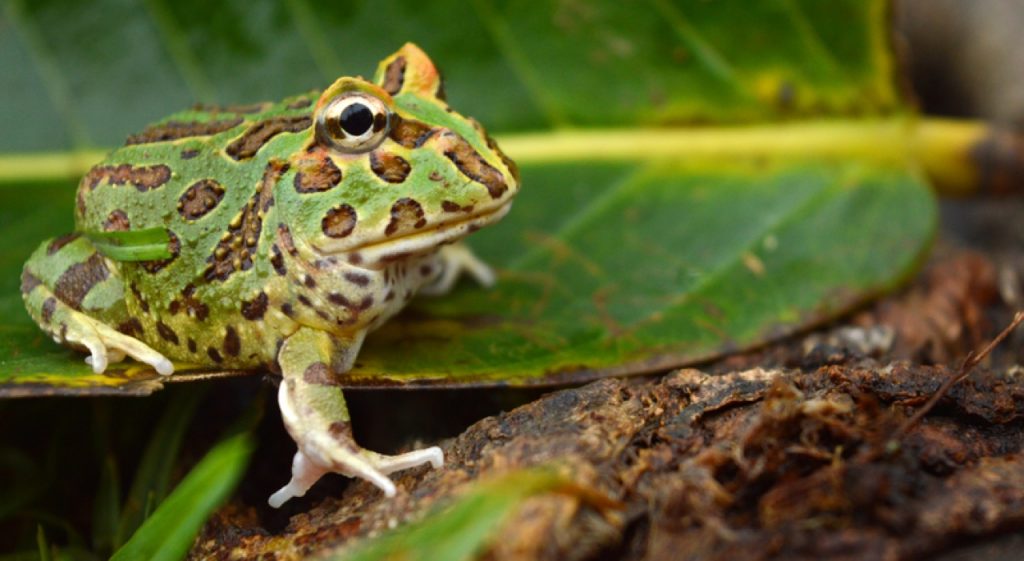
Why is the Pacman frog a common choice for a pet frog?
This frog is on the top of the list because he is very easy to care for and the setup required is very easy compared to other species. Also, the diet of the Pacman frog is easy.
The Pacman frog mostly eats crickets. Be sure to be safe when you feed him because when Pacman frogs feel threatened or mistake your finger for food, they can bite.
Setup:
Housing a Pacman frog isn’t that difficult. They do not need a large cage and since they aren’t very active, a 10-gallon tank is more than enough for one Pacman frog.
I especially say “one” Pacman frog because they tend to eat their tank mates and that is why they should be housed alone.
Substrate:
The substrate is one of the most important aspects of the terrarium of a Pacman frog.
Choose the right one and the substrate will be easy to maintain and function well for your Pacman frog.
The best substrate to use for your Pacman frog is coconut fiber. It is easy to maintain and it will perform well for your Pacman frog.
Lighting:
Special lighting isn’t required for this frog. They don’t require sunlight, but they do need lighting that mimics daylight in their habitat.
Even Ordinary household fluorescent bulbs can be used to light a Pacman frog habitat.
Heating:
Pacman frogs need an almost constant air temperature of 75 degrees Fahrenheit.
You can do this best by stick a heat mat on one side of the glass terrarium.
This heatmap then is regulated using a thermostat to make sure that the temperature stays constant.
Fun facts to know about the Pacman Frog
- Pacman frogs live in South America. specifically in Argentina, Brazil, and Uruguay.
- Females will not call or croak as often as males.
- Pacman frogs are known to be cannibalistic so house them as individuals.
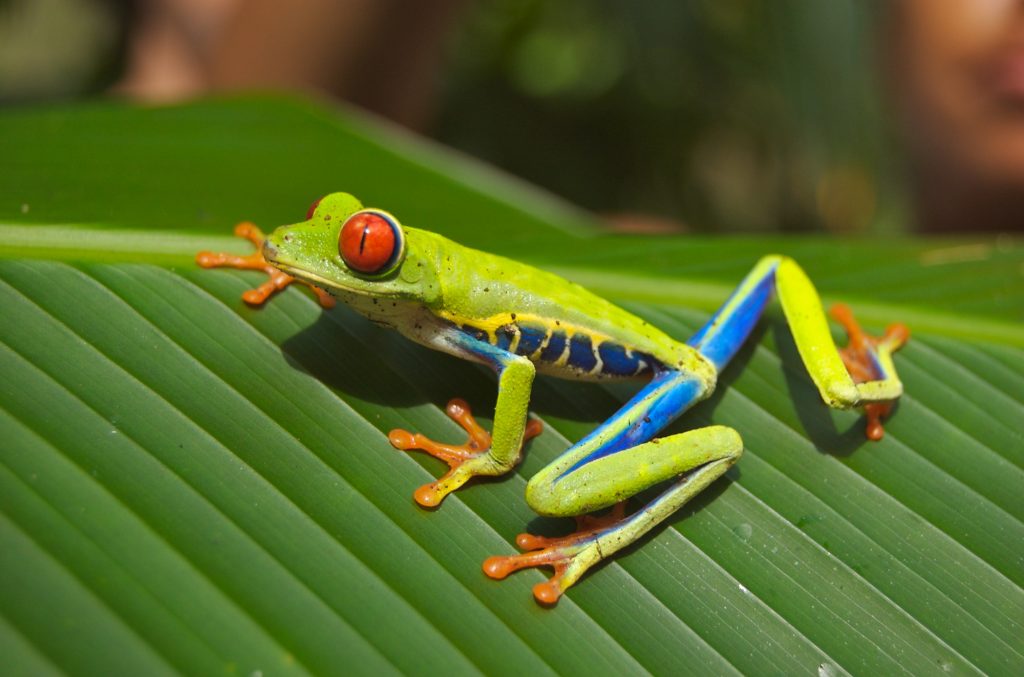
Red-eyed tree frog:
Name: Red-eyed tree frog (Agalychnis callidryas)
Length: Adult males are only about 5 cm (2 inches). The females are 7.5 cm (3 inches)
Lifespan: The Red-eyed tree frog lives for about 5 years
Why The Red-Eyed Tree Frog?
Red-eyed tree frogs are one of the most asked for pet frogs in pet stores.
Nothing wrong with that, but you need to have the proper setup for it.
As long as you have that, there is no reason not to choose a Red-eyed tree frog.
Setup:
This species can grow quite large so you would need a terrarium that is at least 45x45x60 cm.
This would be enough for 1-2 frogs and need humidity, warmth, and UVB.
Red-eyed tree frogs do need some things in their terrarium for you to hold them as pets.
Humidity is a controversial subject with these frogs. During the breeding period, they like the humidity to be 90%. Other times of the year they prefer between 60% and 70%.
As for warmth and temperature, the frogs thrive in a temperature range of 75 to 85F. You can drop this to even 10 degrees lower in the night.
Substrate:
The substrate of the Red-eyed tree frog should be one that helps with maintaining healthy levels of humidity but also one that is easy to clean.
Also, it would be a must that it is resistant to mold and fungus.
When we look at the above requirements, coconut fiber would be the ideal choice.
EcoEarth, Cocosoft chips and Compressed coconut bricks are all great choices.
Lighting:
Red-eyed tree frogs do have some natural cover, but still, get a fair amount of UV.
I suggest putting a UVB canopy in the terrarium above the mesh ceiling.
In this canopy, you can implement a 5-6% UV tube or you can get a similar compact light.
Heating:
Red-eyed tree frogs need a temperature of 75 to 80 degrees Fahrenheit.
You do this best by sticking a heat mat on one side of the glass enclosure.
Make use of a thermostat to make sure the temperature stays within this range.
Also, Red-eyed tree frogs are arboreal and they love climbing and hiking structures within their terrarium.
Branchy sticks, cork flats, cork rounds, and also plants should be used to make a nice and realistic habitat for the frogs.
Fun Facts About Red-Eyed Tree Frogs
- Red-eyed tree frogs are nocturnal animals which means that they are active during the night.
- Red-eyed tree frogs are carnivores (they like meat).
- Their diet is based on moths, grasshoppers, crickets and flies.
- Red-eyed tree frogs can survive 5 years in the wild.
Pixie Frog
Name: Pixie frog (Pyxicephalus adspersus)
Length: 4 – 10 inches for males, 3.5 – 5.5 inches for females.
Lifespan: Pixie frogs will live anywhere between 12 and 20 years.
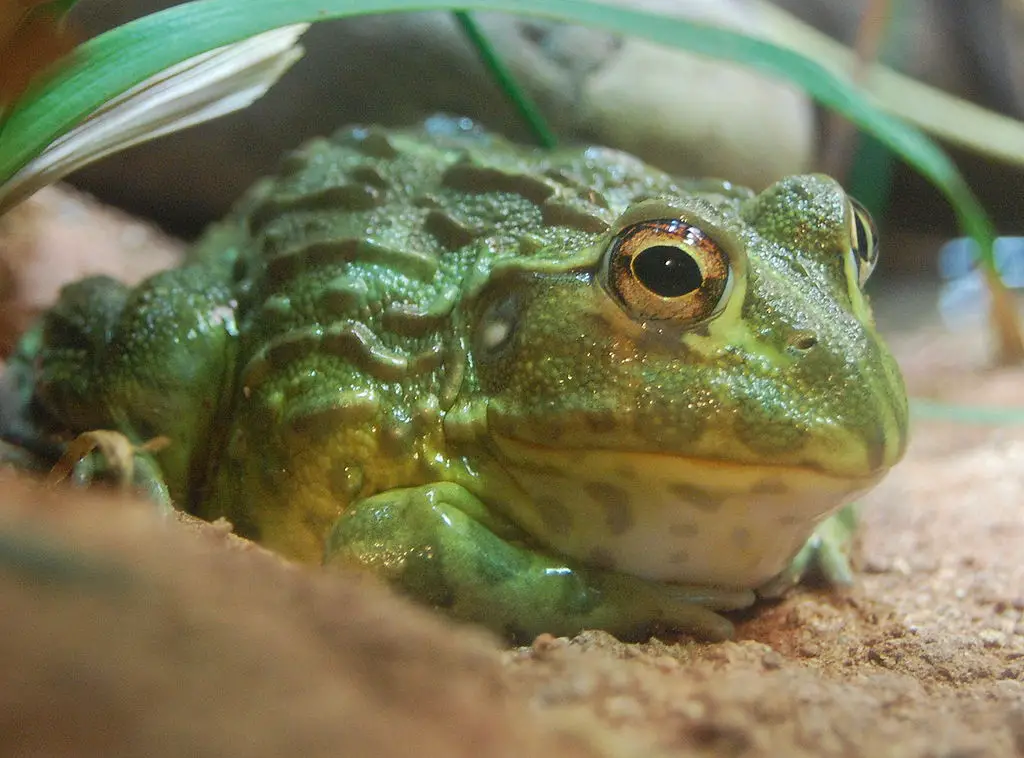
Why is the pixie frog a common pet frog
The pixie frog is the second largest frog species in the world. If you can handle their larger size, this species is great to hold as a pet frog.
They live long (up to 20 years), are hardy, and do extremely well in captivity. Males can grow up to 10 inches and weigh between 2 and 3 pounds.
You can hold pixie frogs together in the same terrarium, but be sure that they have plenty of food and space. They can become cannibalistic when hungry, so if you can, keep them separate (just to be sure)
Setup:
As I said earlier, you best keep your pixie frogs alone in a terrarium due to their cannibalistic nature. If you buy a male, plan ahead and keep him in a 20-gallon aquarium (larger is also ok).
A male can grow up to 10 inches so he requires a lot of space. If you want a female, you can go for a 10-gallon tank because they aren’t as big as the males.
Substrate:
The best substrate for your pixie frog is one that is very damp, but not so damp that it falls apart, starts growing molds and fungi.
I know some people who use paper towels for this, but I personally think that it looks awful.
Besides, that is the fact that you need to change it daily so the maintenance time goes up and your frog can’t bury himself in it.
I would prefer to use topsoil as a substrate for your pixie frog. This will provide a natural look and also offer your frog a place to burrow himself.
Lighting:
You don’t need any special UVB lighting for your frog. Rather, supplement your frog with a D3 vitamin.
Heating:
Pixie frogs need an almost constant air temperature of 75 degrees Fahrenheit. You can do this best by stick a heat mat on one side of the glass terrarium.
This heatmap then is regulated using a thermostat to make sure that the temperature stays constant.
Fun facts about Pixie frogs
- The pixie frog is sometimes called the African Bullfrog.
- The males can get as big as 10 inches and weigh up to 2 pounds!
- These frogs will eat almost everything as long as they can get it in their mouth.
Tomato Frog
Name: Tomato frog (Dyscophus guineti)
Length: Males can reach 2 to 3 inches in length. Females are a bit larger and can reach 4 inches in length.
Lifespan: 6 to 8 years
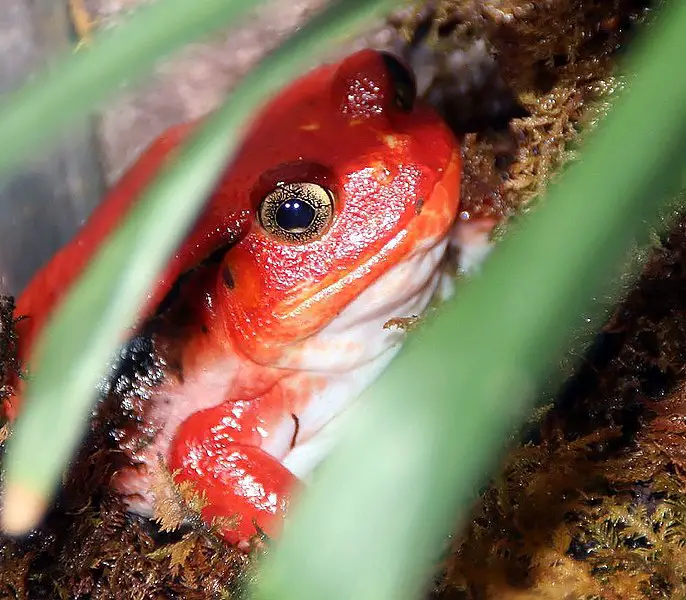
What Makes The Tomato Frog a Good Pet
If you don’t have enough room for a 20-gallon tank, Tomato frogs are the way to go. Tomato frogs do not need a large space and you only need a 10-gallon enclosure to hold 2 of them.
If you want more than 2 Tomato frogs, you would be better off with a 20-gallon long terrarium. Tomato frogs make good frogs because they can be low in maintenance.
They only require food every other day and their diet consists mostly of crickets, nightcrawlers, mealworms, and roaches.
Setup:
A 10-gallon tank is more than enough to hold 2 tomato frogs. If you really want more frogs, you need to go a little bigger with your terrarium. Then a 20-gallon enclosure will do.
Substrate:
Tomato frogs like a substrate that allows them to bury themselves. This ideally would be soil or coconut fiber, like the Josh’s Frogs Bulk Fine Coco Fiber.
When you lay your substrate in the terrarium, provide a depth of at least 2 inches.
Tomato frogs like to bury themselves in order to ambush their prey.
If you are using soil, avoid the ones that are treated with herbicides, pesticides, or fertilizers.
Lighting:
Tomato frogs don’t require special lighting.
Heating:
Tomato frogs require an almost constant air temperature of 75 degrees Fahrenheit.
You can do this best by stick a heat mat on one side of the glass terrarium.
This heatmap then is regulated using a thermostat to make sure that the temperature stays constant.
Fun facts about tomato frogs
- Tomato frogs don’t have teeth. The roof of their mouth is covered with ridges which are used for grinding on their food.
- The tomato frog is active during the night (they also call this “nocturnal”).
- Snakes are natural enemies for tomato frogs.
White Tree Frog
Name: White’s tree frog (Litoria Caerulea)
Length: Males tend to grow towards 4 inches in length. Females, however, are a little bit bigger and can grow as long as 5 inches.
Lifespan: In captivity, White’s tree frogs can live up to or over 20 years, but a more common ages 7 to 10 years.
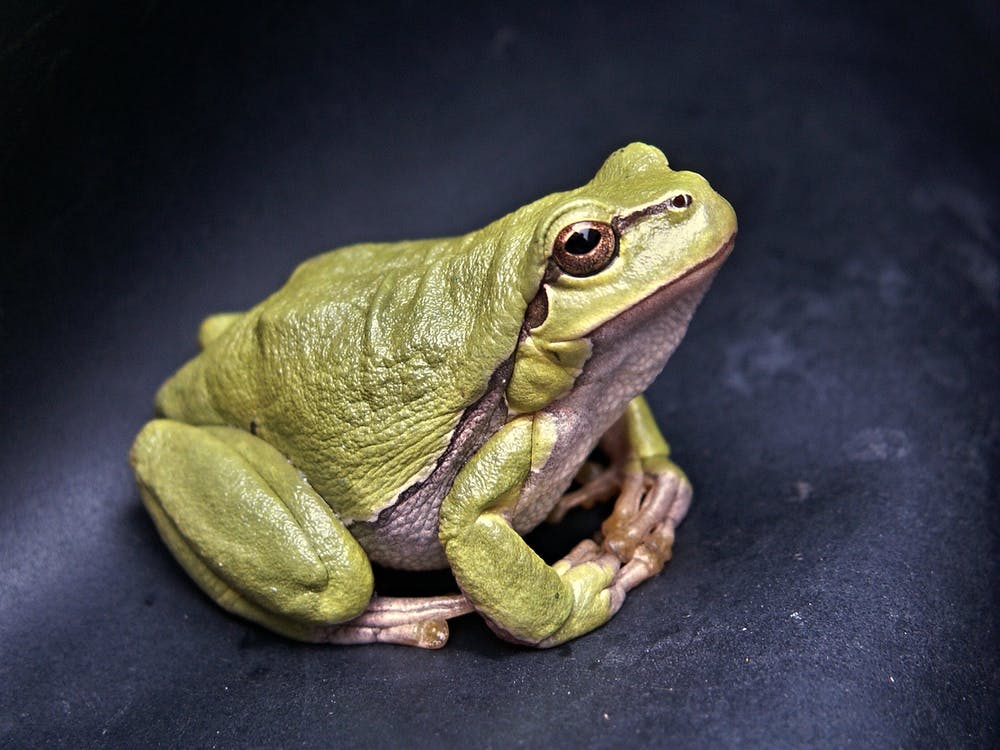
What Makes The White’s Tree Frog Common?
The White’s tree frog (or also called White-Lipped Tree Frog or Dumpy Tree frog), makes a great pet for a variety of reasons.
Their diet is fairly easy because they feed themselves on crickets, earthworms, small mice, and other prey that are small.
Besides that, White’s tree frogs are frogs that can be handled! But before you do, you want to be sure your hands are clean.
Frogs absorb things through their skin and you don’t want anything on your hands that can harm your frog.
Also, know that it is just as important to wash your hands after handling your frog.
Setup:
White’s Tree frogs are fairly easy to house in an enclosure, but as you may know, they are also large.
This means that you need a larger enclosure to house them. A 18x18x24 Exo Terra Glass Terrarium would be a great size to hold 2 juvenile or adult White’s Tree frogs.
Substrate:
Choosing the right substrate is a bit harder to do than choosing an enclosure. This is because the opinions about which substrate to use vary.
Personally, I had the most success with Frog Foam. It works great, is easy to maintain and luckily it is not expensive. I use Frog Foam Terrarium Liner (18×18 Glass Terrarium).
Lighting:
5.0 UVB fluorescent tube or compact lamp is needed for your frog to thrive.
Heating:
White’s tree frogs are very easy when we talk about tank temperature.
They can survive with around 50 degrees Fahrenheit but can also tolerate up to 90 degrees Fahrenheit.
I personally recommend a terrarium temperature between 70n and 80 degrees during the day and you can drop it slightly when going into the night.
Fun facts about White’s Tree Frogs
- The fingers of a White’s tree frog are one-third webbed. Their toes are three-quarters webbed.
- White’s tree frogs have adhesive discs on each finger and toe which help the frog with climbing.
- The skin of the frog is loose and this enables it to take in large amounts of water. This, in turn, is great for living in very dry conditions.
Green Tree Frog
Name: Green tree frog (Hyla cinerea)
Length: The Green Tree Frog is larger than most Australian frogs and can reach about 4 inches (10 cm) in length.
Lifespan: They can live up to 16 years when in captivity.
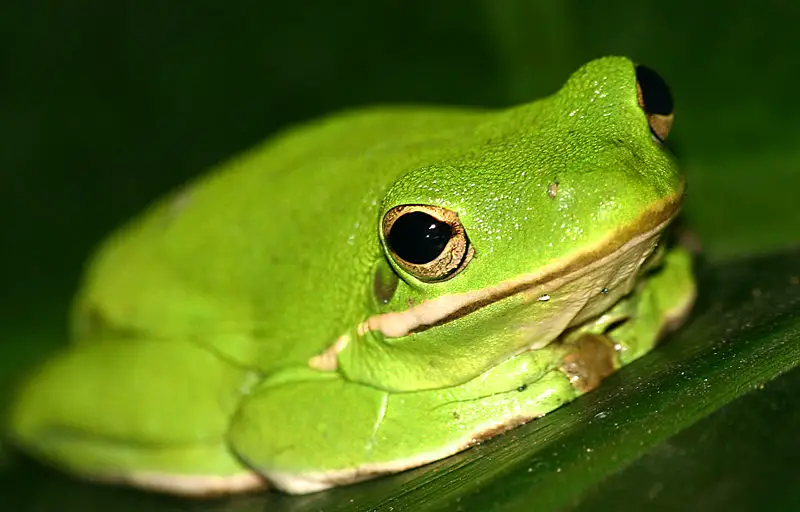
What Makes The Green Tree Frog a Great Pet?
First of all, they are beautiful to watch. Their green color and white stripes along their sides are just stunning.
Green Tree frogs are not only great pets because they look great, but they are also a great choice because they are more active than most of their tree frog cousins.
They don’t like to be handled, but it is awesome to look at them when they are moving.
Setup:
The setup for this green tree frog is very easy. It can be just as simple as a 10-gallon tank, a water dish, and a substrate that hold humidity.
Great choices for this are peat moss, coconut fiber, or sphagnum moss.
Extra things you should know: It is advised to mist the enclosure once daily to boost the humidity. For feeding, it is fairly simple.
Feed them a few crickets, mealworms, or super worms every other day and they will stay happy and healthy.
Another benefit of holding the green tree frog is the fact that they are great at living together! You can generally keep one frog per 2-gallons of space.
Substrate:
Green tree frogs do well on a slightly moist substrate to boost the humidity in the tank a little bit. For the exact substrate, I would use something called coarse orchid bark.
It is a substrate that is very easy to clean. When you see that the humidity isn’t high enough with just the substrate, I would advise you to add a small amount of moss to your vivarium.
Lighting:
In nature, Green Tree frogs are sometimes exposed to natural sunlight. Therefore it is best to give your frog some UVB lighting. But, the right spectrum is very important. A 2.0 UVB would normally do the trick!
Heating:
It is best to keep your Green Tree frogs warm. This is because long exposure to temperatures that are below 10 degrees Celsius can cause the death of the animal. 18 degrees Celcius would be ideal for your frog.
You can do this by putting an aquarium heater in the water and heat the water to a temperature of 24 to 26 degrees Celsius.
You can also make use of a waterfall or another form of water movement. This can help with evaporation and stabilize the temperature and humidity levels.
Fun facts about Green Tree frogs:
- Green Tree frogs are big enough to eat other frogs or small mammals such as mice.
- Green Tree frogs are excellent climbers! They use their sticky fingers to climb steep and wet surfaces.
- You can find the Green Tree frog in northern and eastern Australia. You can also find them in New Guinea.
Related Questions
Can a Pacman frog hurt you? Yes, a Pacman frog can hurt you. This frog can bite when he feels threatened or when he mistakes your hand for food when feeding him out of your hand. This can cause some pain.
How do frogs make their sound? They do this by pushing air from their lungs through their vocal cords. This, in turn, makes the air vibrate and this is how they create their croaking sound. Not all frogs sound the same.
Better said, almost every frog sounds different! This is because the chance of mating is higher when the female knows which frogs are in the pond.
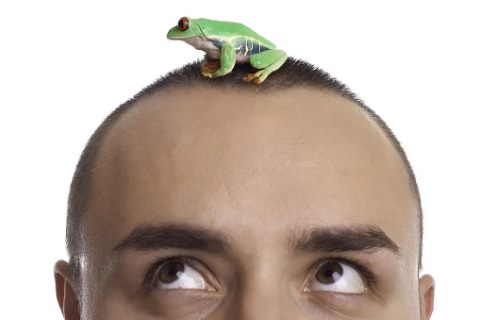
Hi, I’m Mike, and I’m the creator of amphibianlife.com. If there was one word to describe it? It would be: passionate about Amphibians! Whether you want to know more about amphibians or have a presentation to give at school, you’ve come to the right place.

